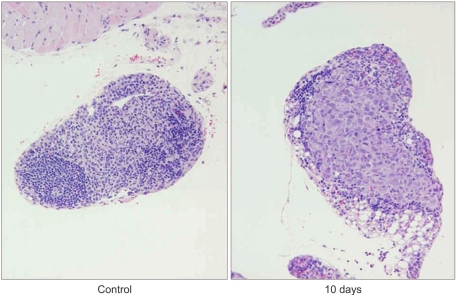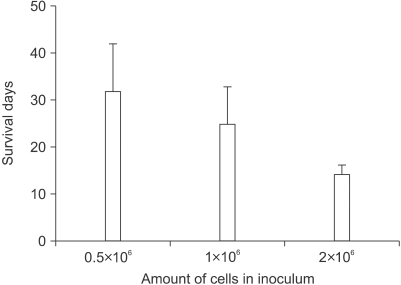Cancer Res Treat.
2006 Dec;38(4):234-239.
Mouse Orthotopic Lung Cancer Model Induced by PC14PE6
- Affiliations
-
- 1Medical Nano Element Development Center, Sungkyunkwan University School of Medicine, Seoul, Korea.
- 2Division of Hematology and Oncology, Department of Medicine, Sungkyunkwan University School of Medicine, Seoul, Korea. kpark@smc.samsung.co.kr
- 3Laboratory Animal Research Center, Sungkyunkwan University School of Medicine, Seoul, Korea.
- 4Department of Biomedical Engineering, Sungkyunkwan University School of Medicine, Seoul, Korea.
- 5Department of Neurosurgery, Samsung Medical Center, Sungkyunkwan University School of Medicine, Seoul, Korea.
Abstract
- PURPOSE
This study was undertaken to investigate in detail the xenograft mouse orthotopic lung cancer model induced by PC14PE6 adenocarcinoma cells.
MATERIALS AND METHODS
Three cell doses (0.5x10(6); 1x10(6); 2x10(6)) of PC14PE6 cells were injected into the lungs of male BALB/c nude mice by the intrathoracic injection method. The lung and other organs, including brain, liver, spleen, kidney, muscle, adrenal gland, and lymph node on knee, were removed and stained with H/E to detect the presence of tumor cells.
RESULTS
The reliable tumorigenicity time in the PC14PE6 adenocarcinoma cell-inoculated BALB/c nude mouse was 10 days after intrathoracic injection. The average life span of the three groups after inoculation was 14 days in the 2x10(6) cells inoculum group; 25 days in the 1x10(6) cells inoculum group; and 32 days in the 0.5x10(6) cells inoculum group. The PC14PE6 adenocarcinoma cells induced orthotopic lung cancer limited within the thorax.
CONCLUSIONS
This orthotopic lung cancer model is an efficient cancer model with easy inoculation methods, rapid and high tumorigenicity, and simple monitoring methods for metastasis.
Keyword
MeSH Terms
Figure
Reference
-
1. Fidler IJ, Kripke ML. Metastasis results from preexisting variant cells within a malignant tumor. Science. 1997; 197:893–895. PMID: 887927.
Article2. Jemal A, Murray T, Samuels A, Ghafoor A, Ward E, Thun MJ. Cancer statistics, 2003. CA Cancer J Clin. 2003; 53:5–26. PMID: 12568441.
Article3. Pelleitier M, Montplaisir S. The nude mouse: a model of deficient T-cell function. Methods Achiev Exp Pathol. 1975; 7:149–166. PMID: 1105061.4. Kubota T. Metastatic models of human cancer xenografted in the nude mouse: the importance of orthotopic transplantation. J Cell Biochem. 1994; 56:4–8. PMID: 7806591.
Article5. Paget S. The distribution of secondary growths in cancer of the breast. 1889. Cancer Metastasis Rev. 1989; 8:98–101. PMID: 2673568.6. Wilmanns C, Fan D, O'Brian CA, Bucana CD, Fidler IJ. Orthotopic and ectopic organ environments differentially influence the sensitivity of murine colon carcinoma cells to doxorubicin and 5-fluorouracil. Int J Cancer. 1992; 52:98–104. PMID: 1500231.
Article7. Kuo TH, Kubota T, Watanabe M, Furukawa T, Kase S, Tanino H, et al. Site-specific chemosensitivity of human small-cell lung carcinoma growing orthotopically compared to subcutaneously in SCID mice: the importance of orthotopic models to obtain relevant drug evaluation data. Anticancer Res. 1993; 13:627–630. PMID: 8391244.8. Onn A, Isobe T, Itasaka S, Wu W, O'Reilly MS, Hong WK, et al. Development of an orthotopic model to study the biology and therapy of primary human lung cancer in nude mice. Clin Cancer Res. 2003; 9:5532–5539. PMID: 14654533.9. Hoffman RM. Orthotopic metastatic mouse models for anticancer drug discovery and evaluation: a bridge to the clinic. Invest New Drugs. 1999; 17:343–359. PMID: 10759402.10. Glinskii AB, Smith BA, Jiang P, Li XM, Yang M, Hoffman RM, et al. Viable circulating metastatic cells produced in orthotopic but not ectopic prostate cancer models. Cancer Res. 2003; 63:4239–4243. PMID: 12874032.11. Furukawa T, Fu X, Kubota T, Watanabe M, Kitajima M, Hoffman RM. Nude mouse metastatic models of human stomach cancer constructed using orthotopic implantation of histologically intact tissue. Cancer Res. 1993; 53:1204–1208. PMID: 8439965.12. Fu X, Herrera H, Hoffman RM. Orthotopic growth and metastasis of human prostate carcinoma in nude mice after transplantation of histologically intact tissue. Int J Cancer. 1992; 52:987–990. PMID: 1459741.13. Wang X, Fu X, Hoffman RM. A patient-like metastasizing model of human lung adenocarcinoma constructed via thoracotomy in nude mice. Anticancer Res. 1992; 12:1399–1401. PMID: 1444197.14. Fu X, Guadagni F, Hoffman RM. A metastatic nude-mouse model of human pancreatic cancer constructed orthotopically with histologically intact patient specimens. Proc Natl Acad Sci USA. 1992; 89:5645–5649. PMID: 1608975.
Article15. McLemore TL, Liu MC, Blacker PC, Greqq M, Alley MC, Abbott BJ, et al. Novel intrapulmonary model for orthotopic propagation of human lung cancers in athymic nude mice. Cancer Res. 1987; 47:5132–5140. PMID: 3621199.16. Goto H, Yano S, Zhang H, Matsumori Y, Ogawa H, Blakey D, et al. Activity of a new vascular targeting agent, ZD6126, in pulmonary metastases by human lung adenocarcinoma in nude mice. Cancer Res. 2002; 62:3711–3715. PMID: 12097279.17. Mase K, Iijima T, Nakamura N, Takeuchi T, Onizuka M, Mitsui T, et al. Intrabronchial orthotopic propagation of human lung adenocarcinoma-characterizations of tumorigenicity, invasion and metastasis. Lung Cancer. 2002; 36:271–276. PMID: 12009237.
Article18. Shiraga M, Yano S, Yamamoto A, Ogawa H, Goto H, Miki T, et al. Organ heterogeneity of host-derived matrix metalloproteinase expression and its involvement in multiple-organ metastasis by lung cancer cell lines. Cancer Res. 2002; 62:5967–5973. PMID: 12384564.
- Full Text Links
- Actions
-
Cited
- CITED
-
- Close
- Share
- Similar articles
-
- Modest Anti-Cancer Activity of a Bile Acid Acylated Heparin Derivative in a PC14PE6 Induced Orthotopic Lung Cancer Model
- The Incidence Rate and Severity of Orthotopic Lung Cancer in an Animal Model Depends on the Number of A549 Cells and Transplantation Period
- Establishment of an orthotopic nude mouse model for recurrent pancreatic cancer after complete resection: an experimental animal study
- Altered Biological Potential and Radioresponse of Murine Tumors in Different Microenvironments
- An orthotopic nude mouse model of tongue carcinoma






